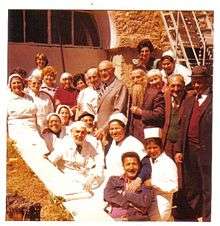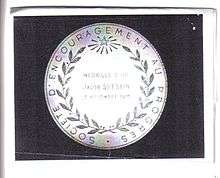Jacob Sheskin
Professor Jacob Sheskin, sometimes known as Sheskin Jacob (Hebrew: יעקב שסקין; 1914 in Vilna, Russia – April 17, 1999 in Jerusalem) was an Israeli physician best known for his 1964 serendipitous discovery that thalidomide can be used as a treatment for leprosy at Hadassah University in Jerusalem.[1]

Professor Sheskin (center, in suit and tie) and his research team at the Jerusalem Hospital in 1980
Awards
- In 1975, the World Academy of Art and Science gave Prof. Sheskin a gold medal for his work.
- in 1997, he was named Yakir Yerushalayim (Hebrew: יַקִּיר יְרוּשָׁלַיִם), or "Worthy Citizen of Jerusalem".[2]

Professor Sheskin's medal
Bibliography
- Sheskin, J. (1975). Thalidomide in lepra reaction. International Journal of Dermatology, 14(8), 575-576.
- Sheskin, J. (1975). The case for invisible leprosy. International Journal of Dermatology, 14(5), 345-346.
- Sheskin, J., Sabatto, S., Yosipovitz, Z., & Ilukevich, A. (1983). Lack of wrinkle formation in the fingertips of patients with Hansen's disease. Confirmation of previous observations. Hansenologia Internationalis, 8(1), 54-60.
- Sheskin, J. (1980). The treatment of lepra reaction in lepromatous leprosy. International Journal of Dermatology, 19(6), 318-322.
- Gorodetsky, R., Sheskin, J., & Weinreb, A. (1986). Iron, copper, and zinc concentrations in normal skin and in various nonmalignant and malignant lesions. International Journal of Dermatology, 25(7), 440-445.
- Wahba, A., Dorfman, M., & Sheskin, J. (1980). Psoriasis and other common dermatoses in leprosy. International Journal of Dermatology, 19(2), 93-95.
- Sheskin, J. (1978). Study with nine thalidomide derivatives in the lepra reaction. International Journal of Dermatology, 17(1), 82-84.
- Sheskin, J., & Zeimer, R. (1977). In vivo study of trace elements in leprous skin. International Journal of Dermatology, 16(9), 745-747.
Footnotes
- "Thalidomide chronology". Grünenthal. Retrieved 2009-07-27.
- "מקבלי התואר יקיר ירושלים בשנים עברו". unknown. Archived from the original on 2011-06-17. Retrieved 2009-07-27.
gollark: I think the main reason is that trees can be resized more easily than hashtables.
gollark: I'm sure you'd like to think so.
gollark: That's just macroscale bees.
gollark: ?
gollark: If you don't know about apioforms, how will you live in today's increasingly bee-based world
References
- Stevens, T., & Brynner, R. (2001), Dark remedy: The impact of thalidomide and its revival as a vital medicine. Cambridge, MA: Perseus.
- Joumel, L. (September–October, 2006). Four awards, one passion: Chemistry. CHEMISTRY International, 19-20.
- The New England Journal of Medicine (2001). Book Reviews. The New England Journal of Medicine, 345(3), 227.
- Brynner, R. (April 03, 2006). Thalidomide and Cancer. 3 Quarks Daily.
- Raza, A. (February, 2002). The third coming: Thalidomide and a final goodbye. The Biochemist. 21-23.
- BBC (January 31, 2005). The return of thalidomide BBC Inside Out.
- Barer, S. (2007). Celgene: The pharmaceutical phoenix. Chemical Heritage Magazine, 24(4).
- Lutz, K. E., (unpublished manuscript). From tragedy to triumph: The approval of thalidomide.
- Penna, G. O., Martelli, C. M. T., Stefani, M. M. A., Macedo, V. O., Maroja, M. d. F., & Chaul, A. (2005). Thalidomide in the treatment of erythema nodosum leprosum (ENL): Systematic review of clinical trials and prospects of new investigations. Anais Brasileiros de Dermatologia, 80(5), 511-522.
- Argaw, A. T., (2004). A study of the anti-inflammatory, anti-microbial and immunomodulatory properties of thalidomide in leprosy. Unpublished dissertation, Louisiana State University.
- European Symposium Myeloma, Waldenstrom (2008) Final Report, Annex 2, p. 19.
This article is issued from Wikipedia. The text is licensed under Creative Commons - Attribution - Sharealike. Additional terms may apply for the media files.